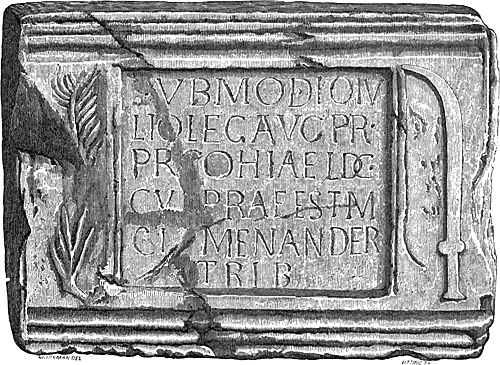
This page created 15 November 2015, and last modified: 15 November 2015

The twelfth officer listed (154.28 in Ingo Maier's numbering scheme) under the command of the Dux Britanniarum following the subsection headed "along the line of the Wall" (item 154.16, per lineam valli), is the Tribunus cohortis primae Aeliae Dacorum, said to be stationed at Amboglanna.
The Tribunus cohortis primae Aeliae Dacorum (154.28) commands what could well be the most frequently-attested cohort in the British epigraphic record: cohors I Aelia Dacorum milliaria, i.e. an extra-large auxiliary infantry unit. Its station as recorded in the Notitia, Amboglanna would appear to correspond to Camboglanna, the fort at modern Castlesteads in Cumbria. However, the unit's epigraphic record is consistently placed, with at least 20 inscriptions from the 3rd century, not at Castlesteads, but at Banna (the modern Birdoswold fort in Cumbria), except for a single inscription from Fanum Cocidi (modern Bewcastle, 11 km to the north), which in any case may date to the early 2nd century.
To account for this, and the missing "c" in Camboglanna, M.W.C. Hassall suggested in 1976 that there was a lucuna in the Notitia's list reading:
154.27 Tribunus cohortis secundae Dalmatarum Magniswhich has become widely accepted, not least because it also supplies the missing but otherwise well-attested cohors II Tungrorum in addition to the missing station of Banna.
154.28 Tribunis cohortis primae Aeliae Dacorum [Banna
154.28.1 Tribunis cohortis secundae Tungrorum C]amboglanna
154.29 Praefectus alae Petrianae Petrianis
One of the more interesting records from Birdoswald is RIB 1885, which gives the unit the title Tetricianorum, showing loyalty to the Gallic emperor Tetricius (271-3/4); other inscriptions (RIB 1883, RIB 1886) show similar titles for the Gallic emperor Postumus (259/60-268). As a large milliaria cohort, the unit was commanded by a tribune even in the 2nd century (tribunes ranked higher than standard military prefects in the Principate, although the opposite was true by the time of the Notitia's compilation).
As the unit is first attested under the emperor Hadrian (reigned 117-138), the title Aelia presumably refers to the him, by far the most famous bearer of the name Aelius: Publius Aelius Hadrianus. The title Dacorum refers to Dacia (modern Romania), from where the unit would have been originally recruited. To judge from RIB 1909 and RIB 1914, the falx (a cross between a sword and sickle, and a stereotypical Dacian weapon) was used as a symbol of the unit.

Dedication slab (RIB 1481) of cohors I Aelia Dacorum.
Public domain image taken from an 1867 book.
As with all limitanei units in the Notitia, the shield pattern of the cohors I Aelia Dacorum is not illustrated; it may have featured a falx.
1. Ingo Maier; "Appendix 4: Numeration of the new edition of the compilation 'notitia dignitatum' (Cnd)"; last accessed 26 October 2015. See also for here for numbering examples. Return
2. M.W.C. Hassall; "Aspects of the Notitia Dignitatum", British Archaeological Reports, supplemental series 15 (1976), Oxford; at p 113. Return
3. John Collingwood Bruce; "The Roman Wall: A Description of the Mural Barrier of the North of England", 3rd edition; Longmans, London (1867); at p 259; online version available here (last accessed 15 November 2015). Return

Return to the Notitia alphabetical unit list page.
Return to my Notitia index page.